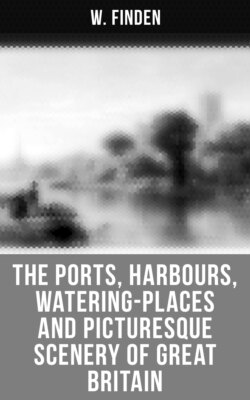Читать книгу The Ports, Harbours, Watering-places and Picturesque Scenery of Great Britain - W. Finden - Страница 25
На сайте Литреса книга снята с продажи.
TYNEMOUTH.
VESSEL ON THE ROCKS.
ОглавлениеTable of Contents
The engraving presents a view of a vessel on the rocks, at the foot of the cliff, to the north-east of Tynemouth castle, as seen from the Ox-fall, in coming from Cullercoat Sands. On the top of the cliff is the lighthouse; in the foreground are various indications of a wreck; towards the middle of the engraving is the vessel "high and dry" upon the rocks; and in the distance, on the left hand, is seen Souter Point, in the county of Durham, about four miles distant from Tynemouth.
The village of Tynemouth, which gives name to an extensive and populous parish, is situated near the mouth of the river Tyne, at the southern extremity of the county of Northumberland. It is a short mile distant from North Shields, about nine miles to the eastward of Newcastle, and two hundred and seventy-six from London. It consists chiefly of one wide street, which runs nearly east and west, with one or two smaller streets to the northward, nearly in the same direction.
The ruins of Tynemouth priory, which, with the adjacent lighthouse, form one of the most conspicuous landmarks on the eastern coast of England, lie to the eastward of the village. The priory is built on a small rocky peninsula, which is bound, from south-west to north-east, by a steep and lofty cliff; and the entrance to this enclosure, which is of about six acres area, is through the gateway underneath the castle. The whole of the enclosed space is fortified according to the rules of modern defensive warfare, and a party of artillery are always stationed at the castle. There is a public walk round the whole of the castle-yard; and the view of the coast, looking either to the north or south, is extremely interesting. From the top of the lighthouse, which stands at a short distance to the north-east of the priory, the Cheviot Hills, on the borders of Scotland, can be plainly seen; and, looking southward, the view extends across the Durham coast as far as Huntcliffe Fort, in Yorkshire; and, in very clear weather, Flamborough Head, which is about seventy-two miles distant, may be perceived.
Although the present castle of Tynemouth, the appearance of which has been considerably altered within the last thirty years, may not be of very great antiquity, yet it is certain that Robert de Mowbray, in 1095, when he entered into a conspiracy to dethrone William Rufus, had a castle at Tynemouth, and that he converted the peninsular area on which it was built into a place of great strength. After a siege of two months, the castle was taken by the king, and the earl escaped to Bamborough. Mowbray, subsequently, being pursued by the king's party, when endeavouring to gain admission into the castle of Newcastle, took sanctuary in Tynemouth church, from which, however, he was dragged by his enemies, and made prisoner.
In 1090, Malcolm III., King of Scotland, and his son Edward, having been slain when besieging Alnwick, were interred at Tynemouth. In 1298, Edward I. visited Tynemouth, and offered a clasp of gold at the shrine of St. Oswald; and, in 1303, his queen resided there while he proceeded into Scotland. In 1381, some monks of St. Albans, who had been engaged in Wat Tyler's insurrection, fled to Tynemouth for refuge on the death of their leader. On the suppression of Tynemouth priory, by Henry VIII., in 1539, the monks were possessed of twenty-seven manors in the county of Northumberland, with various advowsons, impropriations, and other property, both in that county and in Durham. Their annual revenue was valued by Speed at £511 4s. 1½d.; and by Dugdale at £397 10s. 5½d.
The church of Tynemouth priory continued to be used for divine service till about 1659, when, in consequence of its dilapidated state, the foundation of a new church was laid, near to North Shields, on the Newcastle-road. In the reign of Charles II., the lead was stripped off the roof of the old church, by Colonel Edward Villiers, then governor of Tynemouth castle, who also pulled down part of the priory, in order to obtain stones for the erection of a lighthouse and other buildings.
By a grant from Charles II., dated 30th June, 1677, Colonel Villiers, in consideration of building the lighthouse and providing a light, was authorised to demand one shilling from each British, and sixpence from each foreign, vessel entering the Tyne. Since the time of Colonel Villiers, the lighthouse has undergone considerable alterations, and it has also been greatly elevated. Its correct geographical situation is—north latitude, 55° 0' 55"; west longitude, 1° 24' 31". The light, which is a revolving one, is displayed from sunset to sunrise, and may be seen, in clear weather, at the distance of five or six leagues. The light appears in its greatest lustre, like a star of the first magnitude, once a minute; its brilliancy then begins to decline, and at length it becomes totally obscured.
CULLERCOATS.
